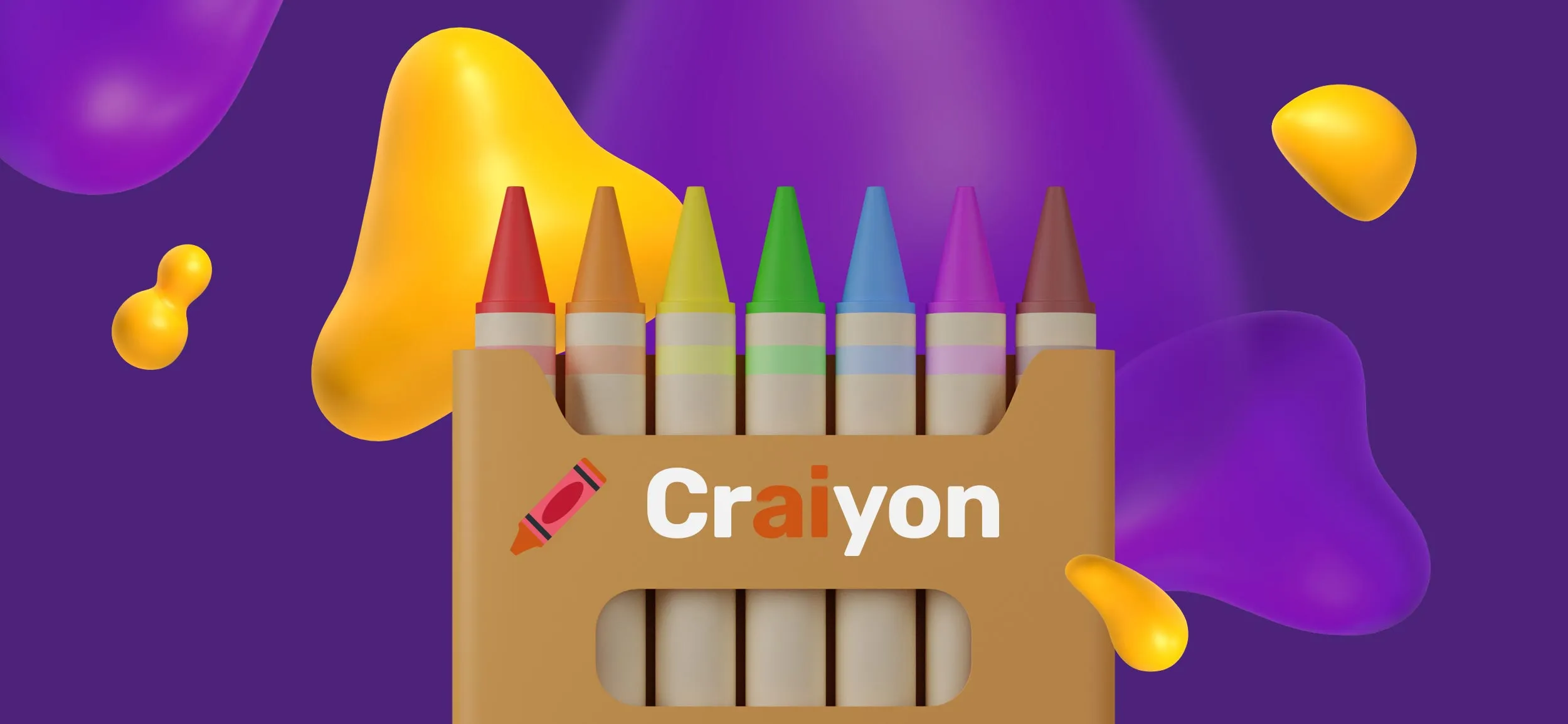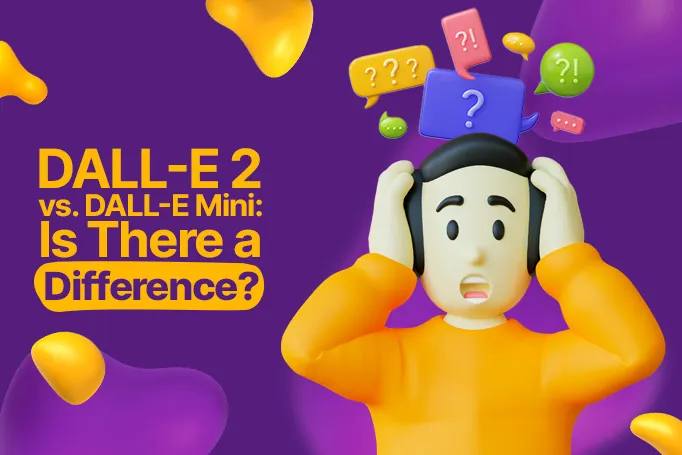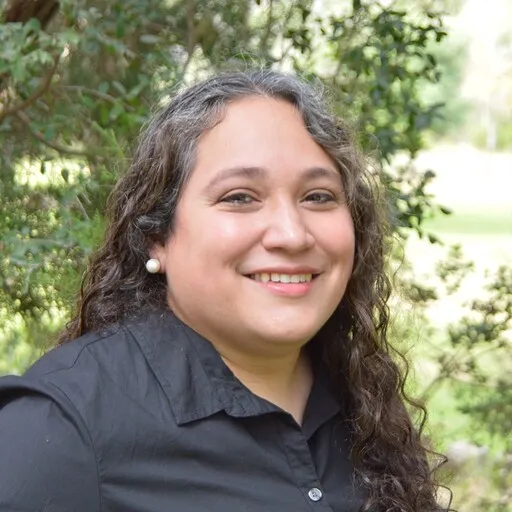You’ve probably heard about AI art generators by now.
We’d be surprised if you haven’t. AI art has been on the rise since AI art generators started popping up a few years ago and, as artificial intelligence technology gets more advanced, we can expect to see more sophisticated and accessible AI developing soon.
One of the more popular AI art generators out there is DALL-E 2 and its little sidekick, DALL-E 2 Mini (Now rebranded to Craiyon).
Is there a difference between them?
Oh, yes.
Though these two text-to-image generators share a name (or used to, anyway), they are two very different pieces of technology.
In this blog, we are diving right into the DALL-E world to give you the 411 on these two art generators and the differences between them, so you can determine which tool is the right tool for you.
What is DALL-E 2?
DALL-E 2 is a very powerful AI model by research laboratory, OpenAI.
This text-to-image artificial intelligence art generator takes a user’s written prompt and uses a database of millions of images to create four relevant corresponding images based on what was written.
DALL-E 2 is able to generate accurate, high-resolution images in just a few seconds too, making it a handy tool.
It also features inpainting and outpainting, which allows users to edit both the inside and outside of any image generated, meaning not only can you edit what’s there, but you can expand the image to have the machine make up what wasn’t pictured as well.
Pretty neat.
And we’re not the only ones to think so! Due to its very creative and high-quality images, folks all over are cranking up DALL-E 2, giving it the strangest prompts they can think of, and sharing the results everywhere they can.
What is DALL-E Mini (Craiyon)?

To avoid confusion with their products, OpenAI politely requested for DALL- E Mini owner, Boris Dayma, to change the name of his AI art generator.
Like most big companies, OpenAI got its way, and, last summer, Dayma did just that.
Now rebranded to Craiyon (get it, crAIyon?), this AI art generator has been generating plenty of traffic online due to its easy accessibility and impressive results.
Whatever name you know it by, Craiyon is also a text-to-image AI art generator that works just like DALL-E 2 does. It takes your written prompt, compares it to a database of images, and generates nine relevant images to match said prompt.
So, now that you know a bit more about these two AI generators, let’s dig more into how they differ from each other.
What’s under the hood?
If you were able to pop open the hood of these two generators, you’d see that they are being run by completely different engines.
Let’s break it down:
DALL-E 2: DALL-E 2 is a very powerful AI model developed by research company OpenAI.
It is their second-generation text-to-image art generator and a vast improvement over its predecessor, DALL-E.
While the technology for DALL-E was based on GPT-3 (Generative Pre-trained Transformer), a neural network machine learning model trained using internet data to generate any type of text, DALL-E 2 is based on the contrastive and diffusion text-to-image models, CLIP and unCLIP.
These new models are the reason that DALL-E 2 is able to generate much more high-resolution images and better “comprehend” a user’s prompt to create more relevant images than DALL-E was able to create.
Craiyon: After the arrival of DALL-E came several more AI art generators all designed to perform the same function.
Craiyon (then DALL-E Mini) was a standout amongst them, made popular by being free and unlimited.
Unlike DALL-E 2, Craiyon is open source, meaning that anyone can use and modify it, and is supported and funded not by OpenAI, but by Google TPU Research Cloud.
It works just like DALL-E 2, though it has a much smaller set of images in its database to pull from.
Users do, however, point out that it has more “knowledge” of pop culture, which is always a good thing for an internet community that loves to make memes.
Do they have any limitations?

DALL-E 2: Probably for the sake of all that is good, DALL-E 2 has restrictions on what kind of content a user can ask it for.
Do we need to get specific?
Fine.
Any requests for nudity or R-rated images will be cancelled. As will any request for anything its language processors deem violent or hate-promoting.
It’s also pretty bad at spelling, choosing to portray words in a garbled mix instead of anything that makes sense to us humans.
And, like all AI art generators, it uses natural language processors to understand your written prompts, which means it might not always accurately interpret the meaning of your text, resulting in humorously inaccurate images.
Craiyon: Because Craiyon is not as advanced as DALL-E 2 and has a smaller set of images to analyze, the art it generates is not nearly as precise, no matter how clear the written prompt may be.
The image quality is noticeably lower than other AI art generators too, even being a little on the cartoony side.
It also has noticeable trouble with faces, which results in contorted, unrecognizable faces (and perhaps some nightmares) on its generated images. It is probably because of this bug that Craiyon has no limitations or restrictions on the kind of content that you can request.
That's right. Unlike DALL-E 2, you can request anything from Craiyon since the faces won’t look human enough for it to be very effective. So, there’s much less of a chance that any images generated resulting in a strongly worded cease and desist letter for you.
How much do they cost?
DALL-E 2: Ah, the best things in life are never free, are they?
Neither is DALL-E 2.
It used to be free until July of 2022, when OpenAI decided to charge users for their images.
Now, pricing for DALL-E 2 is based on a credit system. One credit equals one written request.
On sign-up, you get 50 free credits for your first month to do with as you please (but they don’t roll over, so do it within the month) and 15 credits every month after that.
If you need more, you can always purchase 115 more credits for $15.
Not terribly expensive, but if you want lots of images it can add up. They do offer volume discounts for companies who are working with OpenAI’s enterprise team and for that, they use a pricing system based on image resolution.
Crayon: As mentioned before, Craiyon is totally free, baby.
Generate images nine at a time without paying a thing.
As long as you’re using the Forever Free plan, that is.
If you buy the Supporter Plan or the Professional Plan, however, you can ensure that your text prompts get higher priority than free users during busy times, meaning Professional Plan users likely never have Craiyon go offline for them.
Even though you’re paying for that luxury, it’s not much. Just $5 a year for Supporter Plan and $20 a year for the Professional Plan.
Why so low?
As Craiyon admits on their website, it’s “probably just a mistake.”
<div class="c-blog_comp-cta cc-component-2"><div class="c-blog_comp-cta-left"><div class="c-blog_comp-cta-left-wrap"><img src="https://global-uploads.webflow.com/61cdf3c5e0b8155f19e0105b/63695243d096983691046ac3_Potential-Creative.png" loading="lazy" alt="" class="c-blog_comp-cta-left-img"></div></div><div class="c-blog_comp-cta-right cc-dark"><div class="c-blog_comp-content"><div class="c-text-wrapper cc-mb-32"><div class="c-title-4 cc-bold"><strong>Like to work as a freelancer with consistent income?</strong></div></div><div class="c-text-wrapper"><div class="c-text-2">Designity's collaborative model is designed to give you all of the perks of being a freelancer without the income instability.<br></div></div></div><div class="c-blog_comp-wrapper"><a href="http://designity.com/creatives" target="_blank" class="c-button w-button"><strong>Join Our Creative Community</strong></a></div></div></div>
Which is right for me?
Well, it depends on what you’re looking for and what and how you want to use the images.
Again, DALL-E 2 is by far the more sophisticated and advanced model of the two and the images it produces will be higher quality and more precise than the images Craiyon produces.
Craiyon has a Forever Free Plan, however, so …
The choice is up to you!
Think about the kinds of projects and designs that you create on a daily basis and weigh them against the capabilities of both of these AI art generators.
Do you need precise and photo-realistic?
Something a little more up to date with pop culture?
Something free?
We’ve laid out the facts so all you have to do is decide which works best for you.
What’s your favorite AI text-to-image generator?


